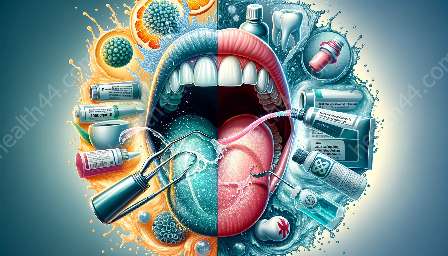Chlorhexidine mouthwash is widely used for oral hygiene, but its impact on the environment and sustainable alternatives are important considerations. Learn more about the environmental aspects of chlorhexidine mouthwash and how it relates to mouthwash and rinses.
Understanding Chlorhexidine Mouthwash
Chlorhexidine mouthwash is a common antiseptic solution used to reduce plaque and gingivitis, and to maintain good oral hygiene. It is effective in killing bacteria and preventing oral infections when used as directed. However, the chemical properties of chlorhexidine raise concerns about its environmental impact, particularly in terms of its use and disposal.
Environmental Impact of Chlorhexidine Mouthwash
One of the major environmental concerns associated with chlorhexidine mouthwash is its disposal. After use, chlorhexidine mouthwash enters the wastewater system, and its residual impact can be detrimental to aquatic ecosystems. The antimicrobial properties of chlorhexidine can disrupt the balance of microbial communities in water bodies, leading to potential harm to aquatic life and even promoting the development of antimicrobial-resistant bacteria.
Moreover, the production and distribution of chlorhexidine mouthwash also contribute to its environmental impact. The manufacturing processes may involve the release of harmful chemicals and energy consumption, leading to carbon emissions and other pollutants.
Sustainable Alternatives
Individuals and dental professionals are increasingly seeking sustainable alternatives to chlorhexidine mouthwash that minimize environmental impact. Some of these alternatives include natural mouthwashes made from plant-based ingredients or those with biodegradable formulations. These sustainable alternatives aim to provide effective oral hygiene without negatively impacting the environment.
Regulation and Best Practices
Regulatory bodies and dental associations play a crucial role in promoting environmentally responsible use and disposal of chlorhexidine mouthwash. Guidelines and recommendations for proper usage and disposal can help mitigate its environmental impact. Additionally, implementing best practices, such as using minimal quantities of chlorhexidine mouthwash per use, can contribute to reducing its overall impact on the environment.
Future Perspectives
As awareness about environmental considerations grows, there is a potential for further innovation and development of eco-friendly mouthwash and rinse products. Research and technological advancements may lead to the creation of oral hygiene products that are both effective and sustainable, aligning with the broader shift toward eco-conscious consumer choices.









